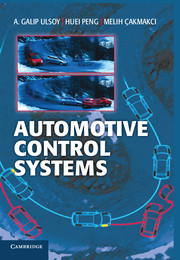Book contents
- Frontmatter
- Contents
- Preface
- Part I Introduction and Background
- 1 Introduction
- 2 Automotive Control-System Design Process
- 3 Review of Engine Modeling
- 4 Review of Vehicle Dynamics
- 5 Human Factors and Driver Modeling
- Part II Powertrain Control Systems
- Part III Vehicle Control Systems
- Part IV Intelligent Transportation Systems
- Appendices
- Index
- References
5 - Human Factors and Driver Modeling
Published online by Cambridge University Press: 05 June 2012
- Frontmatter
- Contents
- Preface
- Part I Introduction and Background
- 1 Introduction
- 2 Automotive Control-System Design Process
- 3 Review of Engine Modeling
- 4 Review of Vehicle Dynamics
- 5 Human Factors and Driver Modeling
- Part II Powertrain Control Systems
- Part III Vehicle Control Systems
- Part IV Intelligent Transportation Systems
- Appendices
- Index
- References
Summary
It often is necessary to consider the human role (i.e., drivers and passengers) in the design of automotive systems. For example, this is evident in the discussion of passenger comfort as a key criterion for suspension design in Chapter 4. Human factors, also known as human engineering or human-factors engineering, consist of the application of behavioral and biological sciences to the design of machines and human–machine systems (Sheridan 2002). The term ergonomics is used as a synonym for human factors; however, it often is associated with narrower aspects that address anthropometry, biomechanics, and body kinematics as applied to the design of seating and workspaces. The terms cognitive engineering and cognitive ergonomics also are used to describe the sensory and cognitive aspects of human interactions with designed systems. All major automotive companies, as well as many government agencies (e.g., U.S. Department of Transportation, U.S. Department of Defense, NASA, and Federal Aviation Administration), have research and engineering groups that address human factors. This chapter is a brief introduction to human factors, especially as they apply to automotive control system design. The introduction is followed by a discussion of driver models, especially for vehicle steering.
Human Factors in Vehicle Automation
Humans (i.e., drivers and passengers) clearly interact with automotive control systems in many ways. Commercial success of a new control technology for vehicles may depend on not only the effectiveness of that technology but also acceptance by customers. Established automotive technologies (e.g., automatic transmissions and cruise control) are widely used in the United States but are less widely adopted in Europe. Navigation systems are more successful in Japan than in the United States. Customer acceptance often depends on many difficult-to-quantify factors. New automotive control technologies in which human factors must be considered carefully include electric vehicles, hybrid electric vehicles, traction control, ABS, intelligent (or adaptive) cruise control, cruise control, airbags, active suspensions, and navigation systems.
- Type
- Chapter
- Information
- Automotive Control Systems , pp. 93 - 116Publisher: Cambridge University PressPrint publication year: 2012

